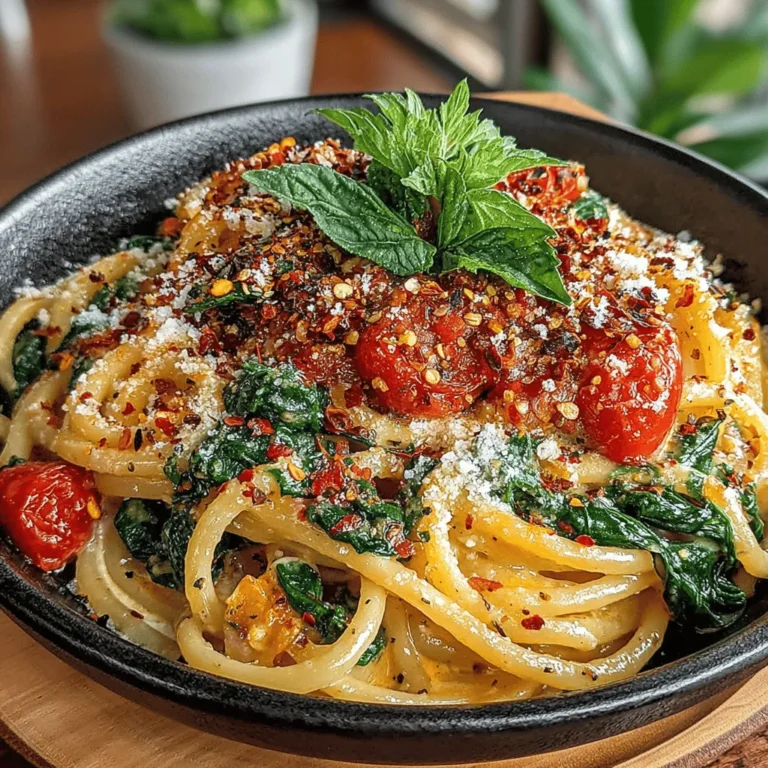Creamy Tomato Basil Pasta with Spinach is a delightful and comforting dish that beautifully blends rich flavors with fresh ingredients. This pasta recipe is not only easy to prepare but also appeals to both novice cooks and seasoned chefs alike. The combination of creamy sauce, vibrant tomatoes, and nutrient-rich spinach makes it a satisfying meal that can be enjoyed any time of year. With its simple steps and accessible ingredients, this dish is perfect for a weeknight dinner or a special occasion.
Ingredients
– 12 ounces pasta (spaghetti, penne, or gluten-free)
– 2 tablespoons olive oil
– 4 cloves garlic, minced
– 1 can (14.5 ounces) diced tomatoes (or 2 cups fresh diced tomatoes)
– 1 cup heavy cream (or a lighter alternative)
– 2 cups fresh spinach, chopped
– 1/2 cup fresh basil, chopped
– 1 teaspoon sugar (optional)
– Salt and pepper to taste
– 1/2 cup grated Parmesan cheese (or a dairy-free alternative)
Instructions
1. Cook the pasta according to package instructions in a large pot of salted boiling water until al dente. Drain and set aside.
2. In a large skillet, heat the olive oil over medium heat. Add the minced garlic and sauté for about 1-2 minutes until fragrant, being careful not to let it burn.
3. Add the canned diced tomatoes (or fresh tomatoes) to the skillet and stir well. Allow the mixture to simmer for about 5-7 minutes to develop the flavors.
4. Pour in the heavy cream and stir until well combined. Let it simmer for an additional 3-4 minutes, stirring occasionally, until the sauce thickens slightly.
5. Add the chopped spinach and basil to the sauce, stirring until the spinach wilts. Season with sugar (if using), salt, and pepper to taste.
6. Toss the cooked pasta into the sauce, ensuring every strand is coated. Add the grated Parmesan cheese and mix until melted and creamy.
7. Serve immediately, garnished with additional basil and cheese if desired.
Understanding the Ingredients
Pasta Choices
When it comes to pasta, there are several options to consider for this recipe. Traditional spaghetti is a popular choice due to its long, slender shape, which pairs well with creamy sauces. However, you can also use penne, which has a tubular shape that holds onto the sauce beautifully. For those with dietary restrictions, gluten-free pasta options are widely available and can be used without compromising flavor.
The Role of Olive Oil
Olive oil is a staple in many kitchens and plays a vital role in this dish. Not only does it add a rich flavor, but it also provides health benefits, including heart-healthy monounsaturated fats. Using quality extra virgin olive oil can elevate the overall taste of your pasta, making it a crucial ingredient in this recipe.
Garlic’s Flavor Profile
Garlic is essential for enhancing the aroma and taste of the creamy tomato basil pasta. When sautéed, garlic releases its natural oils, infusing the dish with a savory depth that complements the tomatoes and cream. It’s important to sauté it gently to avoid burning, which can lead to a bitter flavor.
Diced Tomatoes: Fresh vs. Canned
The choice between fresh and canned diced tomatoes can significantly impact the flavor of your sauce. Fresh tomatoes can provide a vibrant taste, especially in peak season, but canned tomatoes offer convenience and consistency throughout the year. Both options work well, so choose based on availability and personal preference.
Heavy Cream for Richness
Heavy cream is the key ingredient that contributes to the luxurious, creamy texture of the sauce. It creates a rich mouthfeel that balances the acidity of the tomatoes. If you’re looking for a lighter version, half-and-half or a plant-based cream can serve as alternatives, though the texture may differ slightly.
The Freshness of Spinach and Basil
Incorporating fresh spinach and basil not only enhances the dish’s nutritional value but also adds vibrant color and flavor. Spinach is loaded with vitamins and minerals, while basil contributes a fragrant, herbaceous note that brightens the entire dish.
Balancing Acidity with Sugar
Tomatoes naturally have a certain acidity that can be balanced with a small amount of sugar. This is optional but can enhance the overall flavor profile, making the sauce taste more harmonious.
Cheese as a Flavor Enhancer
Parmesan cheese adds a savory, umami-rich flavor to the dish. It melts beautifully into the sauce, enhancing its creaminess. For those with dietary restrictions, there are dairy-free cheese options available that can still provide a similar taste experience.
Step-by-Step Cooking Instructions
Cooking the Pasta
To achieve the perfect al dente texture, bring a large pot of salted water to a rolling boil before adding the pasta. Follow the package instructions for cooking time, and taste a piece a minute or two before the time is up to ensure it is cooked to your liking. Once done, drain the pasta in a colander but do not rinse, as you want to keep the starch that helps the sauce adhere.
Sautéing Garlic to Perfection
In a large skillet, heat the olive oil over medium heat and add minced garlic. Sauté for 1-2 minutes, stirring frequently. Look for a golden hue; once the garlic becomes fragrant and slightly golden, it’s ready. Avoid overcooking, as burnt garlic can impart a bitter taste to the dish.
Creating the Tomato Sauce
Add your diced tomatoes to the skillet with the sautéed garlic, stirring to combine. Allow the mixture to simmer for about 5-7 minutes. This time lets the flavors meld and the tomatoes soften, creating a flavorful base for the creamy sauce.
Achieving Creaminess
When adding heavy cream to the tomato mixture, stir continuously to ensure it blends seamlessly. Maintain a gentle simmer and watch for thickening; this step is crucial to avoid curdling. Stirring helps distribute the heat evenly, resulting in a smooth and creamy texture.
With these steps and ingredient insights, you’re well on your way to preparing a delicious Creamy Tomato Basil Pasta with Spinach that your family and friends will love.

Incorporating Fresh Greens
Timing for Optimal Nutrition
To make the most of the nutritional benefits and vibrant colors of spinach and basil, it’s essential to add them at the right time during cooking. Spinach is best added during the last few minutes of cooking, just until it wilts. This preserves its bright green color and essential vitamins. Basil, on the other hand, should be added just before serving to retain its aromatic qualities and flavor. By timing the addition of these greens correctly, you ensure that they contribute both visually and nutritionally to your creamy tomato basil pasta.
Combining Pasta with Sauce
Achieving Flavor Harmony
Once your pasta is cooked al dente, it’s crucial to combine it with the sauce effectively. Start by reserving a cup of pasta water before draining. This starchy water can help to adjust the consistency of your sauce if needed. In a large skillet, combine the drained pasta with the creamy tomato sauce over low heat, tossing gently to coat every strand evenly. The goal is to achieve a harmonious blend of flavors, so take your time to ensure the pasta absorbs the sauce perfectly.
Finishing Touches
Presentation and Serving Suggestions
The final steps can elevate your dish from simple to stunning. Once combined, remove the pasta from heat and stir in freshly grated Parmesan cheese, allowing it to melt into the sauce. For presentation, serve the pasta in a large bowl or individual plates, garnishing with extra basil leaves and a sprinkle of Parmesan on top. A drizzle of olive oil can add a nice finishing touch, enhancing both flavor and appearance.
Nutritional Benefits of Key Ingredients
Pasta as a Comfort Food
Pasta is not just a delicious comfort food; it’s also a great source of carbohydrates, which provide energy for your daily activities. Carbohydrates are essential for fueling both physical and mental performance, making pasta a satisfying meal choice, especially after a long day.
Spinach: A Nutrient Powerhouse
Spinach is an incredibly nutrient-dense vegetable, loaded with vitamins A, C, and K, as well as minerals like iron and magnesium. These nutrients contribute to overall health, supporting everything from immune function to bone health. Incorporating spinach into your meals enhances their nutritional profile while adding a pleasing texture and flavor.
Basil and Its Antioxidant Properties
Basil is not only a flavorful herb but also a source of antioxidants that help combat inflammation and oxidative stress in the body. Rich in essential oils, basil can offer anti-bacterial and anti-inflammatory properties, making it a smart addition to your diet.
Garlic as a Superfood
Garlic is often regarded as a superfood due to its numerous health benefits. It has been shown to support heart health, boost the immune system, and even possess anti-cancer properties. Including garlic in your creamy tomato basil pasta not only enhances the flavor but also adds a nutritional punch.
Understanding Dairy in the Diet
Dairy products like cheese and cream provide essential nutrients, including calcium and protein, which are vital for strong bones and muscle health. Moderation is key, as incorporating dairy into a balanced diet can contribute to overall well-being.
Serving Suggestions and Variations
Pairing with Side Dishes
To create a well-rounded meal, consider pairing your creamy tomato basil pasta with complementary side dishes. Garlic bread is a classic choice that adds crunch and flavor, while a fresh salad with a light vinaigrette can provide a refreshing contrast to the richness of the pasta.
Customizing for Dietary Preferences
This recipe is versatile and can easily be customized to accommodate various dietary preferences. For a vegan option, swap out the cream and cheese for plant-based alternatives. Gluten-free pasta can also be used to cater to those with gluten sensitivities.
Adding Proteins
Enhance your dish by incorporating proteins. Grilled chicken or shrimp can add a savory element, while plant-based proteins like chickpeas or lentils serve as excellent vegetarian options. This not only boosts the nutritional value but also satisfies different dietary preferences.
Spicing It Up
For those who enjoy a bit of heat, consider adding red pepper flakes or a dash of cayenne pepper to the sauce. Fresh herbs like oregano or thyme can also enhance the flavor profile, making your creamy tomato basil pasta even more delightful.
Conclusion
Creamy tomato basil pasta with spinach is a versatile and satisfying dish that can cater to various dietary needs. With its rich flavors, it serves as an excellent choice for family dinners or quick weeknight meals. This recipe not only highlights the joy of cooking with fresh, wholesome ingredients but also provides a delicious way to enjoy a balanced meal. Embrace the experience of creating this flavorful dish at home, and relish the satisfaction that comes from sharing a homemade meal with loved ones.


